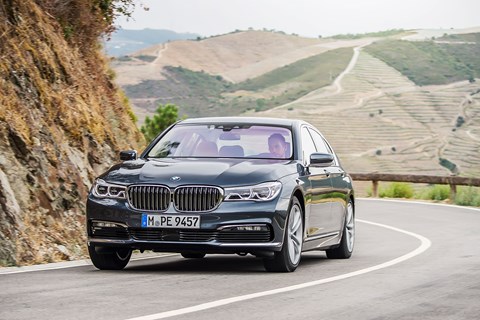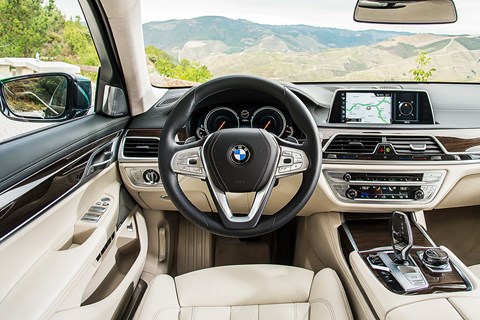► BMW 7-series first drive
► Another luxury saloon from Germany
► Another compelling driving machine
For what is, in principle if not execution, one of the most traditional and conservative of cars, the new 7-series is pretty adept at prompting bouts of child-like wonder. Not merely from the effortless, polished powertrain, the library-at-midnight near-silence of the cabin or the impressively nuanced chassis – they’re almost givens on BMW’s flagship – but for the arsenal of impressively resolved technology packaged into its vast steel, aluminium, magnesium and now carbonfibre structure. (Elements wrought in the latter arrive on Munich’s biggest barge to boost rigidity and reduce weight – by a claimed 130kg – its use made feasible by the 7’s modest volumes and immodest pricing.)
An example. You’re firing down a stretch of gently undulating dual-carriageway, your surroundings of lacquered wood, baby-soft leather and cool aluminium made more inviting still by the evening light’s warm colour palette. The vivid head-up display details your next move via a crystal-clear map. Up front, the car’s kidney grilles open and close to balance a low-drag nose with cooling demands. Cruise control is setting your speed, just as Lane Departure Warning assist, linked to the 7’s now electric power-steering, is keeping you on the straight and narrow. Sounds serene but there’s a problem – Sweet Child o’ Mine’s solo is moments away and it’s threatened by both insufficient volume and an incoming call. So you reach into thin air and, with a curt swipe in front of the iDrive display, decline the call. You then straighten your index figure, as if pointing at the screen, and rotate it clockwise. On screen the Bower & Wilkins volume display appears and ramps up to loud, to better broadcast the strains of the Gibson Les Paul. Is gesture control any safer or easier than twirling a knob? Debatable, but turning a volume knob doesn’t make you smile inside.
Another one. You’re running late for your flight and the only parking bay is tight, too tight to comfortably climb from the broad-of-beam 7. So you park in front of the empty bay, jump out and use the car’s iPad-esque wonder-key to bring up the remote park function. Now watch as your driver-less car uses its cameras and PDC sensors to drive into the bay. Turn off the engine, grab your case and you’re gone. Struck down with OCD just minutes later – did you lock it? Check on the key, while also glancing at remaining fuel range and the status of the lights. And if you’re really bored you can programme the climate control to kick in ten minutes before you get back to the car tomorrow.
21st century luxury with outdated concept design
The new 7-series is BMW’s reconciling of a potentially outdated concept – a three-box luxo-barge – with the 21st century’s idea of luxury. Does luxury still mean floor-to-ceiling leather and carpet of sufficient depth to conceal a cat? Apparently so, but it’s also about choice, and about taking the compromise out of conventionally mutually exclusive attributes such as performance and efficiency, agility and a plush ride, serene isolation (Executive Lounge Seating lets you get almost horizontal in the back seat, all the better to gaze at the Skylounge roof) and being connected (inductive phone charging, 4G Wi-Fi), and having a car that’s almost autonomous with assist systems but that doesn’t also require a six-week pre-flight training course.

With self-levelling air suspension and electro-mechanical anti-roll bars (more efficient and faster-acting than hydraulics), the 7 can be both an engaging cross-country ally and a serene, road-smothering limo. In Comfort Plus the 7 feels S-class comfortable, though it also feels every inch and kilogram of its size and bulk, particularly in long-wheelbase form. But in Sport, which tenses the chassis and drops it lower over the wheels, the 7 delivers driving dynamics beyond those of the Mercedes, with tight, confidence-inspiring body control and steering that, while hardly sparkling thanks to the needlessly chubby rim, is nevertheless direct and encouraging. For the best of both worlds select Adaptive and let the car effectively tune itself as you travel, analysing your driving style together with information from the car’s cameras and nav to optimise the ride and handling. It works well, though Sport’s ride quality is so pliant you may choose to opt for that and leave well alone.
Perhaps remarkably given the complexity of the chassis’ mechanical and electronic systems (peek into the wheelarches and you’ll find NASA-grade machined aluminium hardware and some serious-looking digital and pneumatic plumbing), the big BMW boasts clear lines of communication to each corner of the car, letting you drive with confidence – and even a smile on your face – on roads you’d expect to tie a limo in knots. Do luxury saloon buyers want a backroad playmate? Probably not, which is why for many the S-class is the default choice. But for those who appreciate balance, feedback and a little malleability, the 7 has to be king.
BMW 7-series engine specs
For now both UK engine options are sixes, with a plug-in hybrid to follow. The profligate and oil-allergic can opt for the 322bhp 3.0-litre petrol with its claimed 40.4mpg. But most UK buyers will go for the 730d. On paper its peak power figure of 261bhp looks a little limp for a car of this size but it never feels that way on the road, its ever-present torque – 457lb ft from 2000rpm – and the Skynet-clever eight-speed auto ’box working to deliver ample performance (6.1sec 0-62mph; 5.8sec with xDrive, now available on UK 7-series for the first time) without so much as a suggestion of strain. The hushed, refined diesel is a fine fit for the car and the automatic gearbox similarly talented, whether it’s shuffling into higher ratios imperceptibly or responding to your urgent tugs on the downshift paddle. That said the 7-series doesn’t encourage much interaction with the latter, not least because, with the diesel’s muted soundtrack, it’s easy to blunder into the rev limiter.
Better to sit back and let the car’s far bigger brain take up the slack, and when you do, the intrinsic rightness of the 7’s cabin makes itself known. Some buyers, particularly those with no intention of ever driving, will prefer the S-class’s lounge-like interior, but for clarity, ease-of-use and sophistication, the more car-like but equally artful 7 cabin wins. Yes it’s an obvious evolution of all that has gone before, and of the inside of Munich’s smaller contemporary saloons, but what price an all-pervading sense of calmness and order despite the car’s myriad systems and almost infinite scope for personalisation, from fragrance to severity of back massage?

The traditional iDrive controller accesses most functions, now with a trackpad top that allows for pinch-zooming and swipe-scrolling of maps. It’s backed up by voice and aforementioned gesture control, touch elements to the climate control and a few logically ordered buttons. Sounds like a multi-media horror show; works beautifully. And this is a beautiful cabin generally. Just as the exterior is almost willfully restrained, studded with only the lightest of extrovert touches – the flash of chrome from the vent aft of the front wheels like a comet’s tail, the blue jewellery that denotes optional laser tech in the headlights – so the cabin majors on simple forms beautifully wrought. Witness the way in which Touch Command’s Samsung tablet – upon which you can buy and sell, send emails and check the nav for time to destination – rises from its dock on demand, and the elegant, almost Tate-worthy door handles.
Need to spend a good chunk of your life on the road? This is the car to do it in. For all its innovative, mostly brilliant new systems, the 7 remains a compelling driving machine, one able to morph at will between leather-lined isolation chamber and rewarding, communicative sports saloon. And that’s not something that’s likely to go out of fashion anytime soon.
BMW 730d: the specifications
Price: £64,530
Engine: 2993cc 24v inline six, 261bhp @ 4000rpm, 457lb ft @ 2000-2500rpm
Transmission: Eight-speed auto, rear-wheel drive
Performance: 6.1sec 0-62mph, 155mph (limited), 60.1mpg, 124g/km CO2
Weight: 1755kg
On sale Now: (first deliveries October)
Up against
Better than
Mercedes-Benz S-class: If you enjoy driving
Worse than
Range Rover: But then the Rangie’s more expensive
We’d buy
BMW 730d: And be very happy indeed…
Love: Dynamic flair, tech, deeply satisfying quality
Hate: Dull exterior styling, porky steering wheel
Verdict: Serious saloon brilliance
****